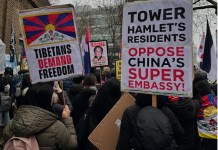India-China border dispute along the line of actual control (LaC) is on the rise after both nations engaged each other in Sikkim and Ladakh. Soldiers from India and China clashed at the border areas of Naku La pass in North Sikkim garnering global headlines.
The border dispute between India and China further fared after Chinese helicopters were spotted near the LaC in Ladakh and were met by Sukhoi 30MKI jets of the India Air force(IAF).
Choppers of the Chinese Air Force were spotted flying close at the LaC in Ladakh after the clashes at the border areas of Pangong Lake and Sikkim erupted. Although the Chinese did not cross into the Indian airspace, the IAF scrambled Su-30 jets to patrol the area.
However, there has been no official clarification if the patrol was a normal occurrence or took place in the wake of Chinese provocative actions.
India maintains two air bases, Leh and Thoise, in the Union Territory of Ladakh. Both countries regularly fly missions and carry out patrols on their respective side of the borders.
However, since the border is poorly demarcated there have been instances of airspace violation. China has been accused of purposely leaving trails after violating Indian airspace to assert its claims over the disputed territory.
India-China Border Dispute
India and Chinese troops engaged each other at Pangong Lake in Ladakh on May 5 this year. Around 250 troops clashed in a fierce battle according to the Times of India.
According to reports, the Chinese troops managed to enter the Finger-4 area of the lake but were halted from moving in further by the Indian Army. The following day, the commanders met after the end of the face-off but tensions in the area still remain high.
Pangong lake is a 135-km long, located in Ladakh and stretches out from India to China. A third of the lake, roughly 45 km stretch, is under Indian control while the rest of the 90 km is under Chinese control.
Only a week later, Indian and Chinese troops got embroiled in a fierce battle at the Naku La sector in Sikkim. The scuffle started during regular patrolling and resulted in a fierce ‘armless’ clash between the soldiers of the armed forces with 4 Indian soldiers and 7 Chinese soldiers needing treatment afterwards.
The situation at the 5,000m high border pass was de-escalated after senior officials and troops engaged in a local-level discussion. Army sources speaking to ANI said that such incidents occur due to the unsettled border dispute, however, this particular incident happened after a long time.
Multifront Attack- Testing Indian Response?
According to geopolitical analysts speaking to the EurAsian Times, the incidents in Naku La and Pangong Lake should not be treated as isolated incidents. In fact, these actions showcase that China is testing Indian response at multiple fronts.
As part of its ploy, the Chinese Navy has also increased in presence in the Indian Ocean as part of its Maritime Silk Route (MSR) initiative led by President Xi Jing Ping.
This has put the Indian Navy on high alert since they remain sceptical of Chinese activities and believe that Beijing is using the cover of MSR to map the Indian Ocean and carry out surveys.
Beijing has been testing the response of countries in the South China Sea and near the Taiwan Strait too. Experts believe China is deploying similar tactics on India as well in a bid to study and observe New Delhi’s response.
India and China have had a turbulent relationship as both nations fought a brief, but bloody war in 1962 and have been regularly involved in border disputes along the LaC as well as in the Indian Ocean.
The India-China border dispute covers the 3,488-km-long LaC, with China claiming the Indian state of Arunachal Pradesh. Both China and India consider the maintenance of peace and harmony to be vital as both nations find a solution to the border dispute.
Only a few years ago, the nuclear-armed countries were involved in the fiercest dispute since the 1960s, as soldiers of both countries were engaged in a 73-day standoff in Doklam. While the two countries have been largely peaceful since 2017, the recent flare-ups could be detrimental to the Sino-Indian relationship.




